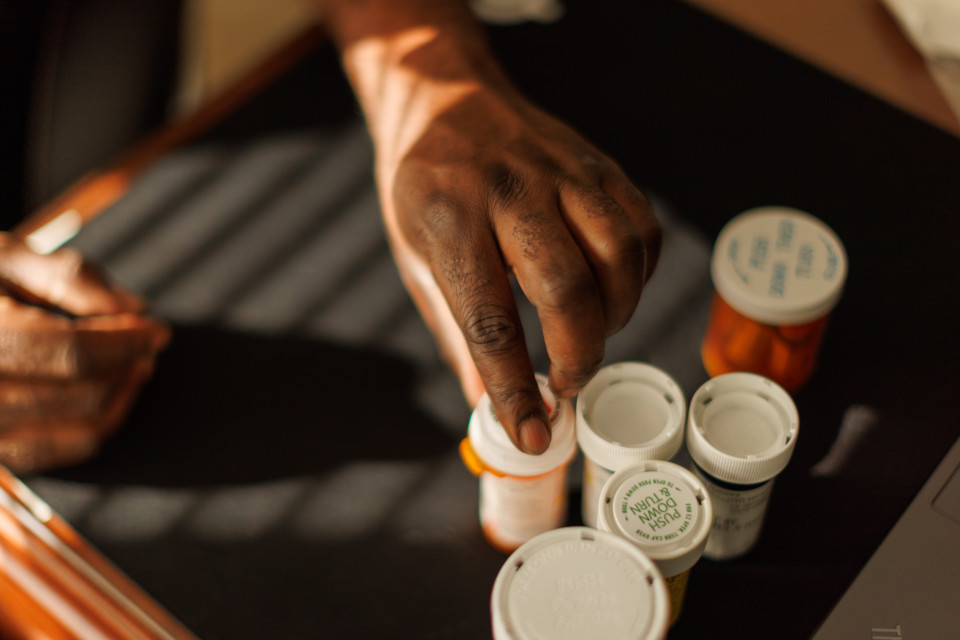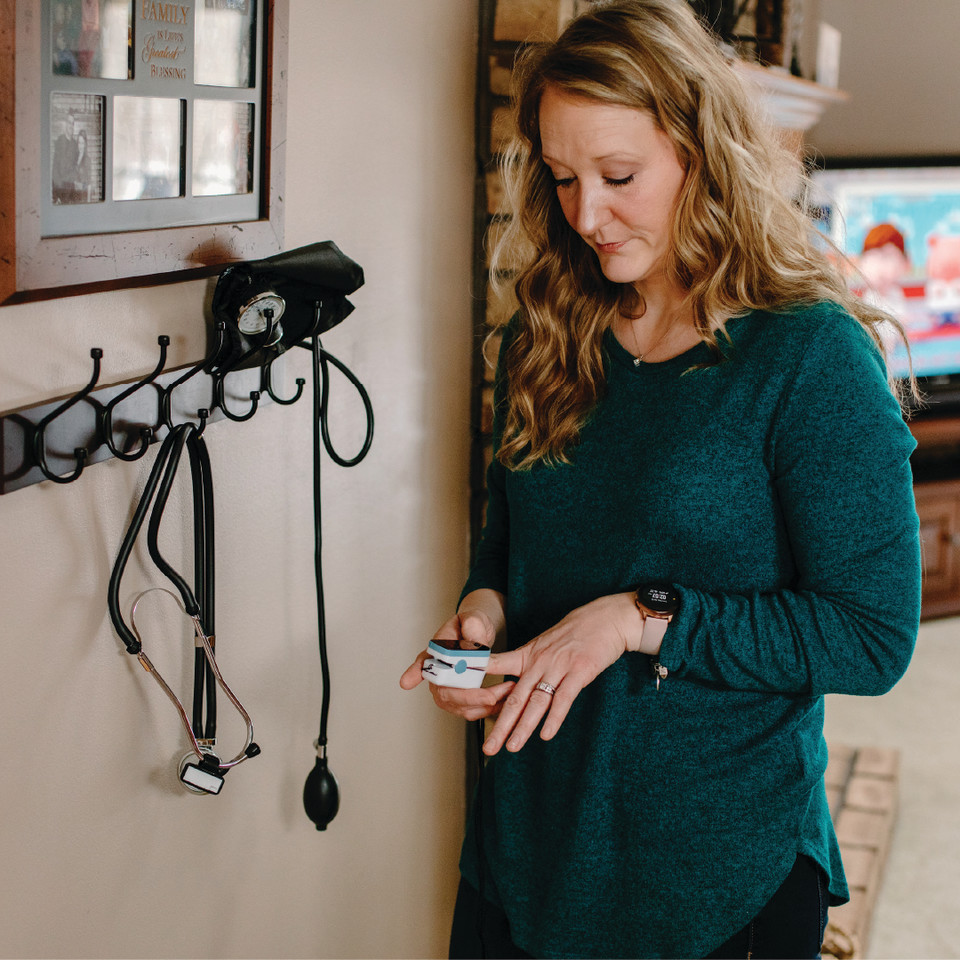
Jzon is living with MS and experienced a relapse at the height of the pandemic.

Jzon is living with MS and experienced a relapse at the height of the pandemic.
The 2022 Medication Access Report is the newest annual deep dive into the challenges people face accessing, affording and adhering to the medicine they need to live healthier lives. This year’s report grounds the latest healthcare trends, original data and industry momentum with real patient stories and experiences.
The following patient stories illustrate larger medication access trends in 2022. For a deeper look into the data driving this year's report, read the full 2022 Medication Access Report.
Like many entrepreneurs, Jzon had to pause his dream of opening a brewery when the COVID-19 pandemic hit. And like many patients living with chronic illnesses, the pandemic brought about a standstill with his healthcare, too.
In July 2020, Jzon walked into an emergency room seeking treatment for a multiple sclerosis (MS) relapse. His medical team had advised him to go to the ER, receive one steroid infusion to mitigate the condition and set up home infusions afterward.

Like many entrepreneurs, Jzon had to put his dreams on hold. He had planned to start a beer brewing business.
Moments later, he walked out of the ER without receiving treatment.
“When I got in, the staff at the ER didn't really want to go that route,” Jzon said. “They wanted to admit me.”
At the time, COVID-19 cases were rising rapidly in Florida, and Jzon could tell many patients in the crowded waiting room were there with COVID-19 symptoms. Although he needed to address his MS relapse to prevent disease progression, he's also immunocompromised and couldn’t risk getting infected.
“I had to refuse treatment that day,” he said.
If not for his self-advocacy, Jzon said he may have been among the 52 people who were at the hospital that day who came down with COVID-19.
In the last year, 1 in 5 patients have delayed or opted out of emergency care, like Jzon.CoverMyMeds Patient Survey, 2021 In total, 84% of patients reported delaying or forgoing in-person healthcare visits due to reduced availability or fears of further illness.CoverMyMeds Patient Survey, 2021
Missed appointments and delays may have contributed to an increased mortality rate recently, too. Some studies estimate 2020 saw over 100,000 excess deaths — those beyond what was expected in a typical year — that were also not attributed to COVID-19.COVID-19 pandemic-related excess mortality and potential years of life lost in the U.S. and peer countries, Kaiser Family Foundation Health-System Tracker, 2021
Discover more data-driven insights and analysis in this year's full report — including how healthcare technology can help mitigate industry-wide affordability barriers. Read the full 2022 Medication Access Report
For those with chronic illnesses, diseases can progress and worsen even when treated — let alone when care is unavailable.
Jzon is one of a growing number of patients who received home infusions.Home Infusion Therapy Market Size, Share & COVID-19 Impact Analysis, Fortune Business Insights, 2021 He prefers home infusions for the convenience and reduced risk of infection compared to a facility with other patients.
But due to staffing shortages, he said, scheduling a nurse to come to his home was often difficult and provided little to no continuity of care.
“I felt threatened that I might have to actually go to an infusion center or a hospital in order to do these things,” Jzon said.
Jzon’s experience was a small capillary in a larger healthcare system that’s still hemorrhaging care team staff.

Jzon received MS treatment at home, but due to staffing shortages, it was often difficult to schedule a provider and there was little continuity of care.
79% of healthcare workers say staffing shortages have affected their ability to deliver patient care
Morning ConsultSeptember 2021 survey
Nearly 1 in 5 healthcare workers have quit their job since February 2020, while some have left due to COVID-19 vaccine mandates.Nearly 1 in 5 Health Care Workers Have Quit Their Jobs During the Pandemic, Morning Consult, 2021 The impact of this “great resignation” is substantial for those who remain in the field, with 79% of healthcare workers saying the shortages have affected their ability to deliver patient care, and 41% calling the impact major.Nearly 1 in 5 Health Care Workers Have Quit Their Jobs During the Pandemic, Morning Consult, 2021
Technology can help mitigate some of the issues caused by staffing shortages by affording team members more time through automation and efficiency — including telehealth visits.
Jzon said his neurology visits were difficult and even sometimes “invalid” because his doctor couldn't perform a tactile test to quantify MS progression. However, he intends to continue using telehealth for check-in visits and mild illnesses.
“It definitely was a boon,” Jzon said. “For all the headaches on one side, on the other side, there's definitely been some positives as far as the interactions and the ease of accessing medical care.”
If there’s part of his medical team that’s been a steady source of support, it’s been Jzon’s pharmacist, with whom he’s on a first-name basis.
After waiting in long lines at a large chain pharmacy, Jzon switched to a small local pharmacy that offered home delivery.

Like 84% of patients, Jzon participated in telehealth appointments. While not as good for his neurology visits, he appreciates telehealth's convenience for check-in visits and mild illnesses.
In 2020, 13% of patients reported most often receiving their medications through home delivery from a local pharmacy. That number increased to 21% in 2021.
CoverMyMeds Patient Surveys2020 and 2021
Many other patients have done the same over the last year. In 2020, 13% of patients reported most often receiving their medications through home delivery from a local pharmacy, and the number increased to 21% in 2021.CoverMyMeds Patient Survey, 2020CoverMyMeds Patient Survey, 2021 The demand for prescription delivery choice is clear for pharmacists: 44% said they’ve started a prescription home delivery program since the start of the pandemic.CoverMyMeds Pharmacist Survey, 2021
While he uses a medication delivery service, which saves him a trip to the pharmacy, Jzon stays in touch with his pharmacist via phone calls. This allows him to ask questions about when to take each drug, new medications and even how to apply for patient assistance programs to help him afford his medications.
In the past 12 months, 37% of patients have relied more on their pharmacists for medical and medication information and 36% for benefit and payment options than before.CoverMyMeds Patient Survey, 2021
While Jzon is currently insured, he hasn’t always been, and said he shudders to think of how progressed his MS would be without affordability options. These included injectable steroid samples when he couldn’t afford infusions.

Over half of patients in the last year have sacrificed life essentials to pay for their medications. Jzon said affordability options have been crucial for him to stay on his therapies.
“(Affordability) conversations always come in to play just due to the fact that continuity of treatment in this country is dependent upon having insurance,” Jzon said. “There's only so long you're going to go being uninsured and getting full treatment for whatever illness may fall upon you. They just don't go together. I've definitely been the proud recipient of quite a few samples in my lifetime that have helped to resolve these situations.”
Understanding affordability options is critical for both patients and care team members, especially when 79% of patients have gone to pick up a prescription and found it cost more than expected.CoverMyMeds Patient Survey, 2021
Providers can help patients get ahead of this with the help of real-time benefit and cost information within workflow. And pharmacists can continue the conversation at the time of medication pickup with in-workflow connections to patient-specific benefit and biopharma company information.
Helping patients understand their affordability options can also help with medication adherence, which became a volatile variable over the last year. Fifty-one percent of patients gave up their medications to pay for bills and essential items, and 56% of patients modified treatment to stretch out prescriptions.CoverMyMeds Patient Survey, 2021
There were several times when COVID-19-related assistance proved to be a godsend.
JzonLiving with MS

Sixty-six percent of patients experienced an increase in anxiety, depression and/or insomnia over the past 12 months. Pandemic-related distancing from loved ones can add another layer of stress.
“It’s the life management juggling act: You borrow from Peter to entice Paul to convince Joe that he doesn’t need to be paid,” Jzon said, recalling his own financial struggles over the past year. “There were several times where COVID-19-related assistance proved to be a godsend.”
Informed conversations with care teams about payment and treatment plans can be especially meaningful during a time when people continue to feel socially distanced and separated from loved ones.
The emotional brunt of the last two years has left 66% of patients with increased anxiety, depression and/or insomnia.CoverMyMeds Patient Survey, 2021 Fifty-four percent of patients have started taking a prescription medication for one or more of these conditions.CoverMyMeds Patient Survey, 2021
“The distance between friends and family and your supportive network in a time of severe illness was greatly impactful,” Jzon said. “It's increased stress and worry about not only yourself, but others and their wellbeing because you know how they're feeling about you and your current predicament.”
Care team members are also experiencing burnout in record numbers, with 42% of physicians experiencing symptoms of burnout and 54% of pharmacists saying they lack time to complete their job effectively.'Death by 1000 Cuts': Medscape National Physician Burnout & Suicide Report 2021, 2021 CoverMyMeds Pharmacist Survey, 2021
While not a panacea, healthcare technology that surfaces the right information at the right time can help automate tasks. This gives care team members time to bring humanity to patient interactions. In this way, they can help more fully address patients as people, especially those managing chronic conditions, in new ways.
“I've managed (MS) through being on (a prescription drug), trying to maintain a healthy diet, some semblance of exercise, living in a stress-free environment,” Jzon said. “All of the holistic things in addition to the medically advised things in order to gain that nirvana that we chronically ill all seek — which is to not be ill.”
Take a deeper dive into the ripple effects of the COVID-19 pandemic on patients, care teams and the broader healthcare ecosystem in the 2022 Medication Access Report.

Patrick had to retire early after losing most of his eyesight due to macular edema caused by diabetes.
The 2022 Medication Access Report is the newest annual deep dive into the challenges people face accessing, affording and adhering to the medicine they need to live healthier lives. This year’s report grounds the latest healthcare trends, original data and industry momentum with real patient stories and experiences.
The following patient stories illustrate larger medication access trends in 2022. For a deeper look into the data driving this year's report, read the full 2022 Medication Access Report.
Patrick has what many might describe as the perfect retirement. He lives on the California coast, fishes regularly and works part-time at a tackle shop. Retirement just came a little sooner than planned after he started to lose his vision.
Patrick assumed his vision loss was because of his job working with fiber optic cables. As it turns out, his vision was distorted due to macular edema — fluid buildup in part of the retina — caused by type 2 diabetes. By finding the right care plan and medications to manage his diabetes, Patrick regained his eyesight.

Through a clinical trial, monthly injections and diabetes management medication, Patrick regained his eyesight and uses technology to stay on top of his medical care.
Through his experiences managing macular edema and diabetes, Patrick can also clearly see where there's room for improvement in healthcare data and communication. As a proactive patient, he’s found his preferred ways to communicate with his healthcare team and optimize his healthcare management. To best help patients like Patrick, providers and pharmacists need dependable, quick access to prescription and patient data within workflow.
To maintain his eyesight, Patrick receives monthly injections in his right eye, the standard of care for macular edema. In his left eye, a port the size of a grain of rice constantly delivers medication, with refills only required every six months, as part of a clinical trial.
For a technology guru, being a human experiment is source of delight.
“I’m the six-million-dollar man,” Patrick exclaimed. “The fact that I've got nanotechnology running through my body? That's very cool.”
While he’s also tech-forward with the rest of this medical care, including accessing medication for his Type 2 diabetes, Patrick sees room for improvement.
53% of providers would prefer to use patient portals as their main communication method with patients, but just 32% are doing so.
CoverMyMeds Provider Survey2021

Patrick appreciates being able to receive quick results for things like his A1C levels through digital connections to his care team.
Patrick is among the 90% of patients who can access medical labs, tests and data through a patient portal — and he takes full advantage of this capability.CoverMyMeds Patient Survey, 2021 He appreciates being able to receive text messages about things like his blood sugar levels — a process that now replaces what may have previously required an appointment.
“Ten years ago ... I never knew what my labs were,” Patrick said. “I never knew what my A1C was until the following month when I would go see a doc. Now, I know instantly.”
Providers would agree the portals are a positive for patient communication outside of appointments. Over half would prefer to use patient portals as their main communication method with patients, but just 32% are doing so.CoverMyMeds Provider Survey, 2021
How do the remaining two-thirds of providers communicate with patients outside of appointments? To learn more, read the full 2022 Medication Access Report
Patrick also takes advantage of the opportunity for two-way information sharing to help improve his health by sending screenshots of fitness app data to his doctor. Real-time data sharing through remote monitoring tools could further cut manual steps out of this process for patients. This lifestyle data can help providers see their patients holistically and help lift the information-gathering burden from care teams.
Data liquidity can also help patients who have multiple providers caring for them, helping improve prescribing, care decisions and even patient safety. When the right patient data is in place, technology can help alert providers of prescriptions or diagnoses that may aid in or interfere with their preferred course of treatment.
“I’ve had to manage three different doctors and get them to communicate on my behalf directly to each other,” Patrick said. “My primary care physician had no idea what was happening with my macular edema. Likewise, my retina specialist had no idea what was going on with any of my other diabetic issues.”

Two-way communication with providers, enabled through open, secure data exchange, can help patients find their best care plan, inclusive of medications and lifestyle management.
Data liquidity opportunities can, importantly, improve provider-patient conversations and shared decision-making at the point of prescribing. Only 25% of providers said they’re able to surface patient-specific benefit information within their EHR.CoverMyMeds Provider Survey, 2021 Those who can’t ranked it as the most valuable data they’d want within their EHR. And it certainly beats guessing: In a recent study, only 21% of prescribers could accurately estimate patient out-of-pocket medication costs without full information sets on patient benefit and insurance cost-sharing.Accuracy of Physician Estimates of Out-of-Pocket Costs for Medication Filling, Sloan et. al., 2021
With accurate medication cost and coverage in front of them, care teams can help patients create a financial game plan to avoid sticker shock at the pharmacy — which 79% of patients experienced over the past year.CoverMyMeds Patient Survey, 2021
Interoperable technology can surface affordability options, such as coupons, discounts and patient assistance programs, which can help patients lower their out-of-pocket cost and feel confident their paying the best price.
Patrick, for instance, said his Type 2 diabetes medication costs $850 a month out of pocket. With insurance, it’s closer to $80. But then his girlfriend, a medical assistant, told him to look for a biopharma company coupon. He found one and lowered his monthly cost to $15.
“If there’s a way to get all of those coupons and savings … and make it so people can get to it and have it readily available and understood, that'd be great,” he said.
Fewer than 25% of providers had plan-specific cost, patient deductible information or pharmacy-specific medication pricing within their EHR.
CoverMyMeds Provider Survey2021

Patrick takes advantage of two-way communication with his provider to send things like daily step count updates that can make positive changes in his health.
Pharmacists and providers need these options in-workflow, but few have it. When asked about prescribing features available within their EHR, 68% of providers had medication-specific information and 57% had plan formulary alternatives available.CoverMyMeds Provider Survey, 2021 However, a quarter or less of providers had plan-specific cost, patient deductible information or pharmacy-specific pricing within their EHR.CoverMyMeds Provider Survey, 2021
During a normal week, 84% of pharmacists are helping patients with benefit questions, but most are likely having to search multiple places to help find this information. Only 36% of pharmacists said they can surface patient-specific benefit information in their system, and just 41% can surface manufacturer discount card options.30
Data flow and communication between providers and pharmacists could also help improve the healthcare experience for patients like Patrick.
Both groups are experiencing unprecedented staffing shortages, a situation that amplifies the strain of each error and inefficiency. Pharmacists are often spending time on the phone calling providers about medication rejections, quantities and drug interactions, though 80% would prefer to do so through electronic methods.CoverMyMeds Pharmacist Survey, 2021 Direct plan connections would allow electronic, automated benefit verification and investigation workflows, taking the load off pharmacists and providers.
Cleaner data can help patients avoid confusion as well. Patrick recalled a situation in which there was no clarity in how often he should be taking a medication.
“The doctor prescribed TID (three times per day), the medication online said QID (four times per day) and what the pharmacist printed out was BID (twice per day),” he said. “It's like, which of you guys are right? I had to verify with the doctor which way he really wanted this to be administered.”
Unclear or missing data like this takes time to resolve and keeps Patrick away from fishing. For other patients, it could be time they have to take off work for a second trip to the pharmacy or childcare they must pay for on top of medication and healthcare bills. It also puts undue time and effort stress on providers and pharmacists.
To best serve patients, and help overburdened care teams, healthcare systems and pharmacies need integrated technology that surfaces the right data at the right time. Stakeholder commitment to improving patient care can help improve communication, health literacy and, further, patient outcomes.
Even as systems improve, Patrick is aware he may have to continue being a diligent advocate for his own health — and thinks other patients should do the same.
“I think one of the questions you should ask (yourself) is how well informed do you think you are?” he said. “About your medications, about the delivery systems, about any of (your healthcare)?”
Read more about what it will take for data liquidity to improve across the healthcare ecosystem in the 2022 Medication Access Report

Though Kristy is living with primary myelofibrosis, the right medication helps her lead a healthy, active life with her family.
The 2022 Medication Access Report is the newest annual deep dive into the challenges people face accessing, affording and adhering to the medicine they need to live healthier lives. This year’s report grounds the latest healthcare trends, original data and industry momentum with real patient stories and experiences.
The following patient stories illustrate larger medication access trends in 2022. For a deeper look into the data driving this year's report, read the full 2022 Medication Access Report.
Kristy’s living with myelofibrosis, a rare bone marrow cancer, but considers herself healthy. Since her diagnosis over a decade ago, she’s had two babies and been on the same medication since 2013. The unchanged prescription, though, has been the only constant regarding managing her medication.
Often, medication access journeys don’t take straight paths. They’re winding roads or mazes that can circle back to previous destinations, contain dead ends and even U-turns. This can be especially true for a specialty medication like Kristy's.

With only one option for medication, Kristy has no choice but to manage access challenges that often come with specialty therapies.
Due to insurance switches, shifting formularies and pharmacy changes, Kristy's had to overcome both access and affordability challenges over the years. She's become unwillingly familiar with the denial and appeals process, with her medication sometimes covered under pharmacy benefit and others under medical benefit. As a result of these variances, she’s paid as little as $38 a month and as much as $1,900 a month for the same medication.
These cost swings can make family budgeting hard — and take an emotional toll on someone who's already managing a complex disease.
“I feel like I’ve been through the fire with this medication,” Kristy said. “It’s been really scary not knowing if my medication was going to be covered.”
Only 51% of providers felt they had the necessary benefits information to start patients on specialty medications.
CoverMyMeds Provider Survey2021

Kristy has one option for treatment, an injectable medication, and has paid anywhere from $38 to $1,900 for it, depending on coverage.
Because of the often-complex nuances involved in specialty medications, the best solutions in helping patients get continuous access to their medications combine technology and human expertise.
Integrated technology for each member of the care team can help patients get ahead of insurance requirements through total visibility and direct connections with all stakeholders. Most specialty medications will require prior authorization or additional insurance verification, yet only 51% of providers felt they had the necessary benefits information to start patients on specialty medications.CoverMyMeds Provider Survey, 2021
For more details on provider challenges and opportunities at the point of prescribing, read the full 2022 Medication Access Report.

A medication helped Kristy through her pregnancies, even with primary myelofibrosis, but it wasn't always affordable or easy to access.
Information that can affect a patient's medication coverage, such as route of administration, could help providers prepare patients for what to expect when it comes to out-of-pocket cost and payment options. For example, Kristy's current insurance doesn't cover injectables, which made her medication ineligible for coverage.
While some patients in this situation may be able to look at different treatment options, especially if their provider can view alternatives in their EHR, Kristy’s only choice is to find ways to lower her medication costs.
“I don’t have a different treatment option,” she said.
Solutions that consider patient affordability options in addition to and outside of insurance can help connect patients to patient assistance programs, biopharma company resources and even patient advocacy organizations. Luckily, Kristy found a non-profit organization that offered copay assistance.
I didn’t have a choice in leaving it at the pharmacy ... so you pull out the credit card and swipe.
KristyLiving with Primary Myelofibrosis

Solutions that help automate specialty medication processes can give providers more time with patients to discuss condition-specific health management.
These solutions can also give care team members more time to hold affordability conversations with patients, who could benefit from a plan and knowing what to expect before going into the pharmacy or receiving medication delivery.
While Kristy’s myelofibrosis is managed and her health stable, she had to take an anticoagulant during her pregnancies to prevent blood clots. When she went to pick up her medication at the pharmacy, she experienced what 79% of patients have over the last year: a higher-than-expected price tag on her necessary medication.CoverMyMeds Patient Survey, 2021 Her medication was $700. She did what 1 in 4 patients also did when encountered with sticker shock at the pharmacy: paid for the medication.CoverMyMeds Patient Survey, 2021
“I didn't have that kind of extra cash just lying around, but I didn't have a choice in leaving it at the pharmacy either,” Kristy said. “So, you pull out the credit card and swipe.”
Specialty pharmacies can help smooth the road for patients on their way to medication adherence. Many patients on specialty medications rely on their specialty pharmacist for affordability, medication, condition and administration information.The 2020 Economic Report on U.S. Pharmacies and Pharmacy Benefit Managers, Drug Channels Institute, 2020
However, manual processes can contribute to specialty pharmacy workflow inefficiencies, as more than 40% of faxed specialty prescriptions require a call back to the provider.Automating Specialty Pharmacy: Identifying Gaps, NCPDP, 2015 Integrated solutions could help with these manual processes, and especially alleviate overworked specialty pharmacists — 41% of whom cited inadequate staffing as a reason for inadequate time during the workday, the same percent that cited administrative tasks as a reason.CoverMyMeds Pharmacist Survey, 2021

Kristy is grateful to have her health, as she knows many in the rare disease community face medication challenges on top of feeling ill.
Through interoperable technology, pharmacists could have these manual processes automated. This move could help pharmacists provide value-added services for patients like finding affordability programs, which can have a measurable impact on patient medication adherence. Kristy said her specialty pharmacy has helped her find copay assistance programs to help her afford her medication.
Despite the challenges, Kristy’s thankful to have her health and her family and understands the plights many in the rare disease community face.
“I've shed many, many tears over trying to jump through hoops to get the medication and the debt that the medication’s caused,” Kristy said. “I can't imagine jumping through all those hoops and going through appeals and denials on top of feeling ill.”
Learn more about how interoperability can help improve care team experiences when prescribing complex medications and patient time to therapy in the 2022 Medication Access Report

Marley enjoys her job as an esthetician, has built out a van camper with her fiancé during the COVID-19 pandemic and will get married this year. She's also living with stage 4 breast cancer.
The 2022 Medication Access Report is the newest annual deep dive into the challenges people face accessing, affording and adhering to the medicine they need to live healthier lives. This year’s report grounds the latest healthcare trends, original data and industry momentum with real patient stories and experiences.
The following patient stories illustrate larger medication access trends in 2022. For a deeper look into the data driving this year's report, read the full 2022 Medication Access Report.
Marley is living with metastatic breast cancer. But she’d rather you know her as Marley, the travel enthusiast who renovated a camping van with her fiancé. Or Marley, the pet parent to a dog named Beans. Or even Marley, the 28-year-old esthetician with a wicked sense of humor who knows San Diego like the back of her hand.
It's important her care team understands her personal inclinations as well, including the emotional toll managing cancer can take on her. For a few weeks after her initial diagnosis, Marley opted to have a caregiver, her mother, take any calls from her provider.
“I was 26 and definitely an adult on paper, but emotionally, I was overwhelmed,” she said. “I was at capacity.”
Personalized, transparent healthcare options for both patient and care teams can help incorporate all variables that can affect treatment plans and enlighten the best path forward.
While healthcare is becoming increasingly digital, the ways patients best receive and manage care vary on an individual basis. Care team and pharmacy solutions should address patient needs and preferences, which can help patients hold some control over their circumstances, bringing calm amid chaos.
Solutions including digital patient risk assessments can help meet individual patient needs such as social determinants of health and communication preferences. However, most providers don’t have this information within their EHR. Just 25% of providers surveyed had patient domestic environment information, 14% literacy information and less than 10% had transportation or household income information for their patients.CoverMyMeds Provider Survey, 2021

Marley's medication is an oral pill rather than a chemotherapy infusion, which gives her more time for things like camping in the van she and her fiancé renovated.
In one survey, 63% of patients said the thought of healthcare and medication bills is more distressing than the possibility of death.
National Patient Advocate Foundation

Some patients, like Marley, find freedom in connecting with their care teams through asynchronous models — which many providers also prefer when it comes to communication.
While some prefer digital communication through patient portals, and 90% have access to them, others may prefer phone calls or even in-person conversations to best receive and understand certain types of medical information.CoverMyMeds Patient Survey, 2021 For example, some patients may opt to do telehealth appointments over the phone instead of through a digital device. Some, like Marley, may find better connection and personal freedom through asynchronous care models, such as using messaging apps, that can save care teams and patients up to 17 minutes compared to synchronous telehealth visits.The basics and benefits of asynchronous care, Becker's Hospital Review, 2021
At her hands-on job as an esthetician, Marley is often with clients during normal business hours and can’t stop for a phone call. Because of this, it’s easier for her to communicate routine messages.
“No one wants their esthetician answering the phone during an (appointment),” Marley said. “My nurses know I won’t answer the phone.”
Due to its efficiencies, providers are also using asynchronous care to address care team burnout — exacerbated from the COVID-19 pandemic — and help burdened patients who have had to change their normal approach to medical care.Asynchronous virtual health: 3 reasons it’s critical for now and foundational for the future, MedCity News, 2020 While 62% of providers use phone calls as their primary method of communicating with patients, 68% would prefer to use asynchronous messaging as their primary patient communication method.CoverMyMeds Provider Survey, 2021

Marley finds fulfillment in going to work, but by working, she doesn't qualify for state-funded health insurance. Her monthly premium and healthcare costs are the equivalent of her rent, she said.
My options are: I pay to work or go on disability.
MarleyLiving with breast cancer
Patient choice and individual circumstances can prove even more influential when it comes to healthcare and medication affordability.
Due to COVID-19-related shutdowns in her industry, Marley was out of work for several months during 2020. During this time, her medical care was more affordable because she qualified for government-funded medical coverage. Her monthly premiums were low, and she said she paid “almost nothing” for her care.
While many cancer patients don’t feel well enough to work during treatment, Marley does and finds fulfillment in her career. She went back to work as soon as she could, however, the price of doing her job showed up in her out-of-pocket medical costs. She’s paying the equivalent of her rent on insurance premiums and worries about going into medical debt.
“My options are: I pay to work or go on disability,” she said. “I have to choose between trying to have normalcy or being a cancer patient. There might come a time where that is who I need to be — I might need to be in treatment full time — but it's not who I want to be right now.”
In one survey, 63% of patients said the thought of healthcare and medication bills is more distressing than the possibility of death.Needs Navigation, National Patient Advocate Foundation, 2021 While risk-factor screening is a start to helping patients holistically, acting and measuring outcomes could reach patients where they are and help improve medication access and outcomes.
To help patients plan for and afford their medication expenses, patient-centered support solutions can help care teams connect patients to appropriate intervention services such as biopharma-sponsored affordability assistance, adherence expertise, mental health services and even financial care planning.

A greater emphasis on health literacy in technology can help patients better understand and be in control of their medication access decisions.
A greater focus on health literacy is another step in the direction of patient-centered healthcare. Whether receiving clinical or benefit information in-person or digitally, communication should be considerate of patient comprehension levels, which could hinder health outcomes. An estimated 15-27% of the U.S. population has limited health literacy.Improving Health Literacy Could Prevent Nearly 1 MillionHospital Visits and Save Over $25 Billion a Year, UnitedHealth Group, 2020
As patients receive more lab results, medication directions, and scans almost instantly, sometimes before their providers do, they need outputs to be understandable and accessible.
Marley initially discovered she had metastatic breast cancer when she received test results in her patient portal and ran an internet search prior to talking to her doctor. She’s among half of patients who perform online searches for healthcare information before and after diagnoses and during treatment.Move the Needle: Amplifying the signal for patient services, Accenture, 2021
“It doesn’t tell you what everything means — it’ll just tell you if it's good or bad,” she said. “So, I saw red exclamation points...I saw a number and then (searched for) what it meant.”
This experience is why Marley prefers to use her patient portal for routine provider communication but wants to discuss any labs or test results in person with her provider, who communicates effectively with her about test results and her care plan.
“My doctor is kind and doesn't ‘doctor speak’ a lot, so she makes it really transparent,” she said.
A trusting relationship can make it easier for patients to bring up financial or medication concerns. These conversations — and the information captured in them — can help patients get ahead of delays at the pharmacy, especially for cancer patients. About 72% of oral oncology drugs, like those that Marley takes, require prior authorization, which delayed patients getting medications by a median of seven days and 14 days for one quarter of patients.Prior Authorizations for Oral Cancer Drugs May Delay Time Patients Receive Therapy, CURE, 2021 Technology can help care teams get ahead of these delays, reducing time to therapy by 13.2 days, in some cases.CoverMyMeds data on file, 2018
Solutions that free up time for providers to address high-value patient concerns, as well as those that digitally connect patients to necessary resources, can help fully address all variables that can affect patient care and medication access for patients like Marley.
To read more about patient-centric medication access solutions and opportunities, read the 2022 Medication Access Report.
Press inquiries:
media@covermymeds.com
The Medication Access Report is developed in consultation with an advisory board of healthcare experts representing major organizations across the industry — each with unique perspectives, interests and opinions.